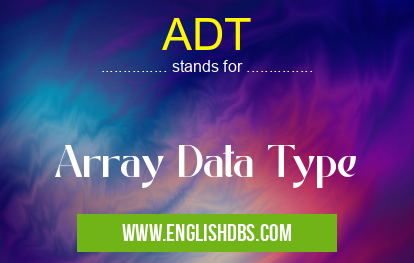What does ADT mean in UNCLASSIFIED
ADT stands for Array Data Type. An array is a data structure that can store a fixed-size sequential collection of elements of the same type. An array is used to store a collection of data, but it is often more useful to think of an array as a collection of variables of the same type instead.

ADT meaning in Unclassified in Miscellaneous
ADT mostly used in an acronym Unclassified in Category Miscellaneous that means Array Data Type
Shorthand: ADT,
Full Form: Array Data Type
For more information of "Array Data Type", see the section below.
Structure
An array is defined by its element type and the number of elements it can hold. The element type can be any valid data type, such as integers, floating-point numbers, characters, or even other arrays. The number of elements in an array is fixed at compile time and cannot be changed once the array has been created.
Indexing
Each element in an array is accessed through an index. The index is a non-negative integer that specifies the position of the element in the array. The first element in the array has index 0, the second element has index 1, and so on.
Operations
The most common operations performed on arrays are:
- Accessing elements: The value of an element in an array can be accessed using the index of the element.
- Inserting elements: New elements can be inserted into an array at any index.
- Deleting elements: Elements can be deleted from an array at any index.
- Searching elements: The index of an element in an array can be found by searching for the value of the element.
Essential Questions and Answers on Array Data Type in "MISCELLANEOUS»UNFILED"
What is an Array Data Type (ADT)?
An Array Data Type (ADT) is a structured data type used to store a collection of elements of the same type. Each element in the array is accessed through its index, which specifies its position within the array.
What are the advantages of using an Array ADT?
Array ADTs offer several advantages, including:
- Efficient data access: Elements in an array can be directly accessed using their index, making data retrieval and manipulation highly efficient.
What are the disadvantages of using an Array ADT?
There are some potential drawbacks to using an Array ADT:
- Memory consumption: Arrays require contiguous memory allocation, which can lead to memory wastage if the array is not fully utilized.
What are common operations performed on Array ADTs?
Common operations performed on Array ADTs include:
- Initialization: Creating a new array and specifying its size and element type.
When should I use an Array ADT?
Array ADTs are suitable for situations where:
- Data elements are of the same type and are accessed frequently.
Final Words: Arrays are a powerful data structure that can be used to store and organize data. They are efficient to use and can be easily accessed and modified. Arrays are used in a wide variety of applications, including:
- Storing data in memory
- Passing data between functions
- Representing data in files
- Creating data structures such as linked lists and trees
ADT also stands for: |
|
| All stands for ADT |
